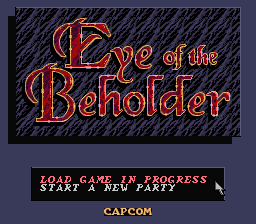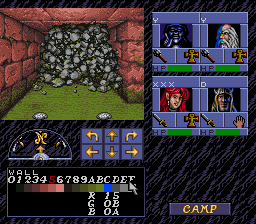Advanced Dungeons & Dragons: Eye of the Beholder (SNES)
| Advanced Dungeons & Dragons: Eye of the Beholder |
|---|
|
Developer: Capcom
|
A SNES adaptation of the DOS original, Capcom took the expansive computer game and fit it not only onto a smaller screen, but also a cartridge with lower storage capacity.
The SNES version enhances the graphics and sound from the computer version, and even adds in-game music to the experience. The game is also compatible with the SNES mouse to try and resemble the original. However, with a controller, the game can be much more difficult to play.
Palette Editor
Pro Action Replay (PAR) code 7E00CE01 enables a palette editor which can be accessed in-game. Press Select once during gameplay to edit the current wall palette, twice to edit the current monster palette, and again to return to the game.
Press Left/Right to select an individual color within the palette, and Up/Down while holding A, X, or Y to edit the selected color.
In addition to editing palettes, pressing Start while the palette editor is open will skip through dungeons.
Interestingly, right after the code which sets RAM address 7E00CE to zero at the title screen, the game checks Controller 1 to see if L + R + B + Select are being held down at the same time. This combination no longer does anything, but it may have originally had the same effect as the above Pro Action Replay (PAR) code.
More specifically, the code branches forward if the aforementioned four buttons aren't held down, but the branch distance is zero bytes (most likely due to some important code being deleted), meaning the game behaves the same way regardless of button input.
The Dungeons & Dragons series
| |
|---|---|
| Intellivision | Advanced Dungeons & Dragons |
| DOS | Pool of Radiance • Curse of the Azure Bonds • Secret of the Silver Blades • Pools of Darkness • Eye of the Beholder • Eye of the Beholder II - The Legend of Darkmoon • Eye of the Beholder III - Assault on Myth Drannor • Stronghold • Al-Qadim: The Genie's Curse • Blood & Magic • Descent to Undermountain |
| NES | Heroes of the Lance • Hillsfar (Prototype) • Pool of Radiance • DragonStrike |
| SNES | Eye of the Beholder |
| Genesis | Warriors of the Eternal Sun |
| Sega CD | Eye of the Beholder |
| Sharp X68000 | DragonStrike |
| Windows | Planescape: Torment • Neverwinter Nights • The Temple of Elemental Evil |
| PlayStation 2, Xbox | Baldur's Gate: Dark Alliance • Baldur's Gate: Dark Alliance II |
| GameCube | Baldur's Gate: Dark Alliance |
| Game Boy Advance | Baldur's Gate: Dark Alliance |
- Pages missing developer references
- Games developed by Capcom
- Pages missing publisher references
- Games published by Capcom
- SNES games
- Pages missing date references
- Games released in 1994
- Games released in March
- Games released on March 18
- Games released in April
- Games with debugging functions
- Dungeons & Dragons series
Cleanup > Pages missing date references
Cleanup > Pages missing developer references
Cleanup > Pages missing publisher references
Games > Games by content > Games with debugging functions
Games > Games by developer > Games developed by Capcom
Games > Games by platform > SNES games
Games > Games by publisher > Games published by Capcom
Games > Games by release date > Games released in 1994
Games > Games by release date > Games released in April
Games > Games by release date > Games released in March
Games > Games by release date > Games released in March > Games released on March 18
Games > Games by series > Dungeons & Dragons series

